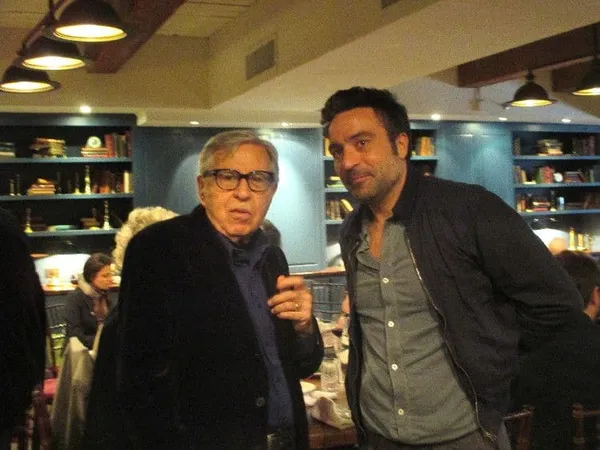 |
| Wondrous Boccaccio co-director Paolo Taviani with Hungry Hearts director Saverio Costanzo at Soho House Photo: Anne-Katrin Titze |
At the Instituto Luce Cinecittà Italian Cinema Sunday Brunch celebrating directors Laura Bispuri, Saverio Costanzo, Cosima Spender and Paolo Taviani, I spoke with producer Marta Donzelli on her work with Michelangelo Frammartino.
Alba Rohrwacher, Flonja Kodheli, Bispuri, Costanzo, Spender and Taviani were joined by Isabella Rossellini and other illustrious guests at New York's Soho House as their films were being screened at the Tribeca Film Festival.
In 2013, the World Premiere of Michelangelo Frammartino's breathtaking 28 minute continuous cinematic installation Alberi in the VW Dome at MoMA PS1 was an official selection of the Tribeca Film Festival.
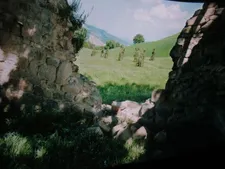 |
| Tribeca Film Festival's Artistic Director Frédéric Boyer on Michelangelo Frammartino's Alberi: "The most important thing is to create something distinctive/instinctive." |
Anne-Katrin Titze: Tell me about your upcoming project with Michelangelo Frammartino. Is it a version of Pinocchio?
Marta Donzelli: Yes, it’s a sort of reverse Pinocchio. He imagines this old man in his mind – this was his inspiration. It’s like Pinocchio becoming a boy and then growing up. Then we have this old man who lives on a mountain in Southern Italy. He is not living on the coast but on the hills close by the coast, the hinterland. You see the sea very far away through his window.
AKT: Where will you shoot this?
MD: We will shoot this summer in Basilicata. It’s the same region where we shot Alberi. He imagines this man who is sick, who is old. He suffers from arthritis because he comes from wood, so he is not so elastic. He lives with his daughter on those hills and his daughter basically takes care of him. His daughter works in a touristic resort on the coast and one day she brings her father to the coast to have a medical checkup within the resort, because she knows a doctor there.
And Pinocchio discovers this sort of toy-land in the resort where the tourists can play games. On that very day, a big whale is stranded on the beach of the resort. That’s the sort of switch. He starts remembering his past life, his origins.
AKT: With Geppetto in the belly of the whale?
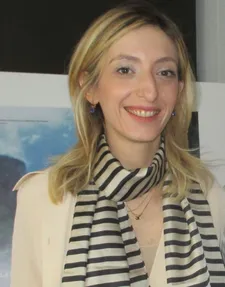 |
| Sworn Virgin producer Marta Donzelli on working with Michelangelo Frammartino: "How to have cinema without having man necessarily be the centre." Photo: Anne-Katrin Titze |
MD: It’s not explicit. You have hints that maybe Geppetto will get him, maybe, maybe not. The film can work with or without this reference. But this reference is important for Michelangelo because in a way we are all Pinocchio. Pinocchio is a big metaphor of how to build a moral backbone for a lot of generations. His film in a way is about an old man who desires to become a tree again. After the event with the big whale coming from the sea.
The rest of the film he starts connecting more and more with the woods again, with nature, until at the end of the film the day of the tree celebration, that was in Alberi, in the village arrives. So the old Pinocchio decides to take part in the celebration against the will of the daughter. Because he is sick and she doesn’t support his being part of that...It is about slowly becoming part of nature.
AKT: Last week, I introduced Stanley Donen’s Funny Face at the French Institute Alliance Française. There is a dialogue between Fred Astaire and Audrey Hepburn’s characters; he is a photographer who wants her to become a model, and he asks her what she thinks is beautiful. She says “a tree”. He says he will make her look like a tree. On the other hand, we are trying to become human every day, like Pinocchio. It’s a question of direction.
MD: Michelangelo’s research in cinema is on how to have cinema without having man necessarily be the center. A film where landscape is the main character.
AKT: The dome at MoMA PS1 was the perfect place to show Alberi two years ago. Were you his producer on all his films?
MD: From Le Quattro Volte [Four Times] onwards. The title of the new film is Late Spring.
AKT: That sounds like an Ozu film.
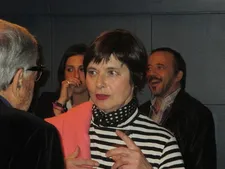 |
| Isabella Rossellini at the Istituto Luce Cinecittà celebration Photo: Anne-Katrin Titze |
MD: Exactly. It’s a quotation. You have this Pinocchio level but also the other sort of storyline within the film - that his daughter because she is taking care of her father is not having her own life. And in a way, when the old man decides to become a tree again, it is also a way to free his daughter.
The following is an excerpt from my conversation with Tribeca Film Festival's Artistic Director Frédéric Boyer during the MoMA PS1 reception for Michelangelo's Alberi. It was Frédéric's second year at Tribeca, after running the Directors’ Fortnight program at the Cannes Film Festival.
Anne-Katrin Titze: Alberi is the first collaboration with MoMA PS1 and Tribeca. How did you connect with Michelangelo Frammartino and his work?
Frédéric Boyer: I know Michelangelo from his previous film. I invited Le quattro volte in 2010 to Cannes. But you know, setting up a cinematic experience in this dome is not easy at all. We needed to bring the sound designer, we needed to get the best projector, everything is technically tricky, but now it's perfect. He has been making this film over two years, doing this is a lot of organization, it's an extraordinary effort. So thank you to all the technicians that made this totally perfect.
AKT: The room has a great atmosphere.
FB: It does. You go in, you lie down and you are not talking about cinema - because we are talking about something different.
AKT: You are fostering new experiences of cinema.
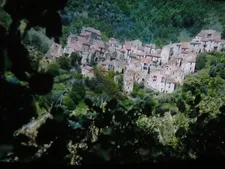 |
| Michelangelo Frammartino: "The tree man belongs to Basilicata, to that small village Satriano." |
FB: It's questions. Michelangelo Frammartino is questioning the future of cinema. What can we do tomorrow? I don't know.
AKT: MoMA PS1 - a former school turned art space is the perfect location to ask these questions. For some people, "cinema people", who never enter a museum or a performance space, this might be an introduction.
FB: Absolutely. I've been watching people come and go for the past two hours and the audience is very young, which is good. You know, the forest is dying and the visuals of Alberi, is a costume of trees and leaves. And it's Tribeca and PS1 and people say "hey, let's watch this!" Michelangelo Frammartino is doing film for everybody. This is not an intellectual cinema. It's a popular cinema. You don't need to know anything. Bring your child - it's something different.
From my Nature of Frédéric Boyer conversation:
FB: Michelangelo explained to me, this was the way he was watching films with his father a long time ago. It is not reinventing, but questioning the idea of the dark room. Watching the film in the dark room. When I introduce, I can't say enjoy this film, I can say enjoy this cinematic experience. When you see the film, the experience is also extremely physical because it is about the relationship between human beings and nature. We cannot say it's a mute film, because there is sound.
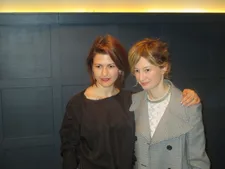 |
| Sworn Virgin's Flonja Kodheli and Alba Rohrwacher, who also stars in Hungry Hearts Photo: Anne-Katrin Titze |
AKT: Indeed not. We are standing outside the dome and we hear rustling and birds and chants. Would you say that you want to challenge the audience with your selections for Tribeca?
FB: Of course!
I spoke with Michelangelo Frammartino on Alberi which is based on the ancient legend of the tree-man Romito, about to disappear from memory in Italy's Basilicata region. He grandly devised a filmic möbius loop that guides the spectators from the foliage of the forest, over the fields, to a compact stone village, into the heart of vegetation, expected and wanted, while night turns to day turns to night.
Anne-Katrin Titze: This is the world premiere of Alberi. Did you create it as site specific, with this location in mind?
Michelangelo Frammartino: When we made it we were not thinking of the dome, we were thinking of a space where people were free to go in and out, so not a cinema. We wanted to create a very free situation. In a cinema, you enter with the opening titles and you go out with the end credits. We wanted everyone to be free to decide when it's enough. They opened the dome two months ago for me to see if it's okay. I was worried, but in the end I said, you know, it's a circular work and the dome is circular. In the end I said, it could work. The sound was made specifically for the dome.
AKT: Now let's move from the location into the story. It's fascinating to watch something without knowing if what you are seeing is the reenactment of a myth, something created for this film, or a ritual that has been going on forever. How much do you want to say about that?
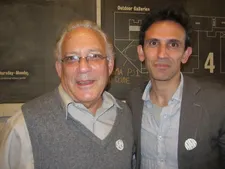 |
| Larry Kardish with Michelangelo Frammartino celebrating the 2013 Tribeca Film Festival World Premiere of Alberi at MoMA PS1 Photo: Anne-Katrin Titze |
MF: What I can say is that I like that you cannot understand, that it is impossible to understand. What I can say is that the tree man belongs to Basilicata, to that small village Satriano. In the tradition it's a disappearing character. No one was keeping it on. I saw a picture of this man [who is covered in leaves and looks like a tree] and I thought, wow, it's wonderful. And I went to the village and they said to me, "Thank you for being interested. Can you help us and give life again to this character?".
AKT: So you decided to resurrect him? Was he alive in the oral tradition?
MF: Yes. They used to dress like this in the winter, going around. When I understood, I was free to invent with them, because we were working together, I decided to make not a lonely character but a collective character, like land art work. So I changed it with their help. And what is nice, now they are dressing again! This change gives life again to the myth.
AKT: Daylight turns into night and into day again. Is there a point in your film that you see more of a beginning than others?
MF: For me, the story changes if you enter at one point or you enter at another. If you enter during the darkness, you see everything, that it's a ritual but if you enter when we are in the forest and see the creatures it's more magic, because in someway you think that they are fantasy creatures and they enter a village. So when you come in the darkness, the forest is a real forest, not magic. What I like in the darkness is that you are connected in a very strong way and I'm always working on connection. So in my movies many times there are darkness moments because you are connected with other people.
Alberi in the VW Dome at MoMA PS1 was presented by Istituto Luce Cinecittà.





















